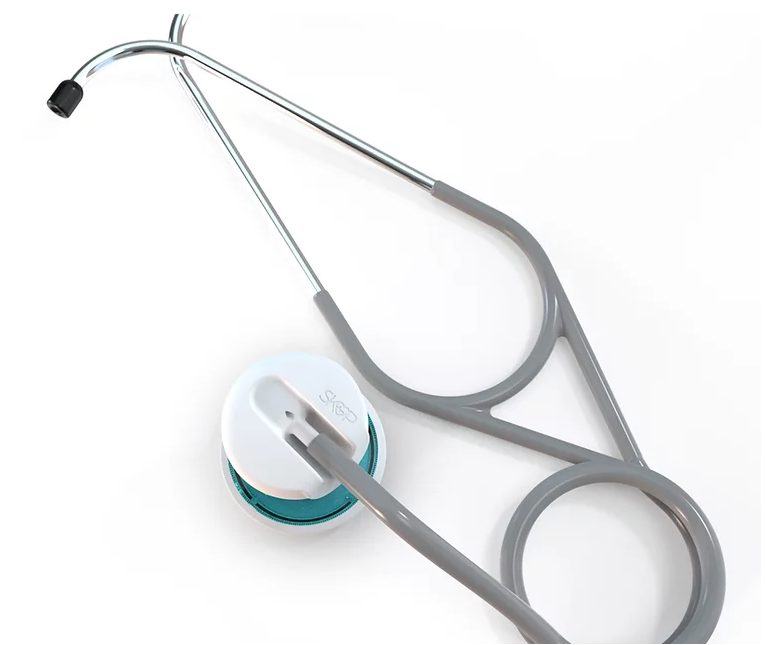- Xometry Joins QLS 820 Manufacturing Partner Network - March 22, 2023
- Weerg Offers Quick-Turn Resin 3D Printing Service by Installing Four NXE 400Pro Printers - March 22, 2023
- Nexa3D Acquires XYZ Printing’s SLS Technology - March 19, 2023
 WeMed, a French startup founded during the Covid-19 pandemic, specializes in designing devices for telemedicine. After discovering the need for remote diagnostic medical devices to relieve pressure in hospitals, WeMed partnered with Nexa3D to help produce the SKOP™ 3D printed stethoscope.
WeMed, a French startup founded during the Covid-19 pandemic, specializes in designing devices for telemedicine. After discovering the need for remote diagnostic medical devices to relieve pressure in hospitals, WeMed partnered with Nexa3D to help produce the SKOP™ 3D printed stethoscope.
SKOP was conceptualized during the first lockdown in France, in April 2020. During this period, healthcare workers were living the reality of what we saw on television: people with Covid-19 were in intensive care or sent home without any possibility of medical follow-up, due to the risk of infection. To help mitigate this, WeMed wanted to create a stethoscope that allows access to a truly remote medical diagnosis, to help substitute the visit
to the doctor’s office.
The SKOP is the first cardiopulmonary auscultation medical device intended for both healthcare professionals and the general public. The device’s acoustic qualities are made possible by cochlear technology that WeMed has developed, inspired by the human ear using biomimicry design concepts. The goal was to make SKOP universal, in its ease of use, connecting to all tablets or phones, as well as telemedicine and communication platforms such as
FaceTime, WhatsApp, and Zoom.
The challenge
WeMed wanted to create a device that is easy to use, universal, and above all financially accessible. Selling a remote stethoscope between 500 and 1500 euros means that the general public would have minimal access to this technology. To suggest that every family will have a stethoscope in their medical cabinet was, although useful in these troubled times, economically unattractive. This meant that SKOP needed to be produced at a low cost to ensure its universality.
To increase speed of production and relieve pressure on healthcare, WeMed wanted to make the SKOP as quickly
as possible, producing at high volumes and speeds, while maintaining quality.
WeMed’s partner Third, a contract manufacturer brought on to leverage its expertise in additive manufacturing to the project, faced a dilemma between production volume and maintaining part quality. While medical devices require irreproachable quality and reproducibility, acoustics is a science that relies on precision and a large production volume was key for this project. To help meet these challenges, reseller Hava3D introduced Third to Nexa3D as the solution.
Nexa3D suggested a technology that offered precision, speed, and reproducibility in one — the NXE 400. After realizing these combined advantages, Third brought Nexa3D into the project.
“Nexa3D seemed seduced by the SKOP project and knew how to respond to our expectations, asking its partners to manufacture resins specific to our needs,” explained Cyrille Lecroq, CEO of WeMed. “The company’s investment of time and energy into the project so that the industrialization of SKOP could be realized made a real difference — collaborating with very young start-ups such as WeMed can be a risk. When we see the quality of our products today, we are very happy that Nexa3D dared to take this risk and that Third made this choice.”
Solution
Other technologies offering the possibility of high-volume 3D printing have a very high cost associated. Nexa3D’s technology allowed production on an industrial scale while offering a sufficiently low production cost. The scale-up costs and complexities that could arise with purchasing a large number of printers has been eliminated by WeMed procuring 20 NXE 400 printers for its partner Third to manufacture the SKOP, bringing a greater return on investment.
Nexa3D printers provide a very high print fineness, which is essential for guaranteeing the acoustic quality of the SKOP. The NXE 400 provides high-volume precision and has a 20x productivity advantage that helped WeMed meet its supply demands and maintain its high quality.
“When it comes to high-demand products like medical devices, speed is essential, and our groundbreaking technology is helping to bridge the gap by providing these ultrafast capabilities,” explained Avi Reichental, CEO of Nexa3D. “Our access to global suppliers enabled us to customize and tailor materials for SKOP and it was extremely rewarding to see WeMed’s revolutionary designs and our technical advantages come together.”
“Nexa3D’s technology is unmatched; it was an obvious choice to bring them onto the project to help meet the high production rates WeMed needed,” said Sonia Tadjdet, Communications Director at Hava3D. “Thanks to the success of Nexa3D’s technology, Third could work with WeMed on smaller adjustments and set up the scaleup production phase.”
Results
SKOP is now CE certified, has obtained marketing authorization in Canada and is in the process of obtaining authorization from the USA. The SKOP responds to a global medical issue — its reach is international and the production volumes Third provides using the NXE 400 must be able to keep up.
SKOP offers the competitive advantages of high-quality 3D printed parts, high-volume production capacities on very short time scales, and an accessible per part cost for industrial production. Its availability helps people access remote healthcare, ensuring everyone receives the level of care they deserve and increasing patient satisfaction. WeMed is now working on several medical devices with a philosophy similar to SKOP, and plans to continue using Nexa3D’s ultrafast technology in the future.
Learn more about Nexa3D’s NXE 400 industrial 3D printer here.
